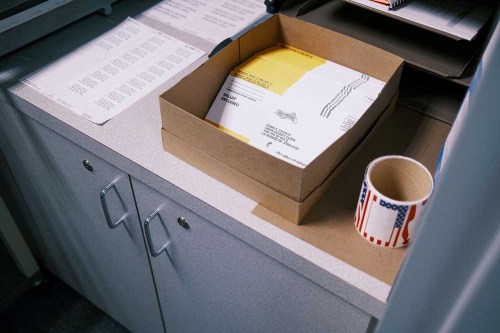Oregon county election offices will get help paying for postmark scanners, other equipment
Published 7:00 am Friday, March 18, 2022

- A stack of ballots sits in the Union County Clerk’s Office, La Grande, as workers count the ballots for the special election on May 18, 2021. County election offices in 2022 will get additional money to replace old election equipment and buy postal barcode scanners to comply with a recent law requiring that ballots postmarked on Election Day be counted.
SALEM — County election offices soon will get additional money to replace old election equipment and buy postal barcode scanners to comply with a recent law requiring that ballots dropped in the mail on Election Day be counted.
In 2021, Oregon legislators allocated $2 million for Secretary of State Shemia Fagan to distribute to counties for election equipment, such as ballot tabulators and postmark scanners, or to add ballot drop boxes and upgrade video surveillance. That money went unspent, and this year election officials asked the Legislature to change what the money could be used for.
Trending
When the money was allocated last year, state election officials were under the impression that many counties needed new tabulation machines, said Molly Woon, senior adviser and strategic projects director in the secretary of state’s office. They found that only one county needed such equipment, and started talking to the Oregon Association of County Clerks about better uses for the money.
A little more than half of the available money will be used for postal barcode scanners and other equipment, and Woon expects to announce grants to counties next week.
Dan Lonai, Umatilla County’s director of administrative services and president of the Oregon Association of County Clerks, said the law went into effect Jan. 1, and counting ballots with Election Day postmarks presents some challenges and drags out counting ballots.
Oregon, he said, with a few exceptions such as challenged ballots, wraps up its ballot totals on election nights.
“Pretty much what the numbers were, that’s how it ended up,” Lonai said.
But counties now have seven days to count ballots with Election Day postmarks as they come in. Lonai said that’s not a good look.
Trending
“Why are your numbers changing?” Well, that’s because ballots are trickling in,” he said.
On top of that, he said, there are times when ballots lack a postmark, such as when two envelops stick together in machinery. To help counter that, however, is a fluorescent postmark on the back of envelopes of a time stamp showing when it went through Portland, where it was sorted, Lonai said, and those postmarks require a special scanner to read.
Umatilla County has two of those, he said, and will test them soon. Smaller counties may lack those scanners and are running into hurdles getting them. The upshot of the county clerks association, he said, is county elections offices can help one another.
“We don’t think we’re going to need them that much,” he said, “but we’re probably going to share them with some of the other counties that didn’t get them because of supply chain issues.”
But on rare occasions, envelopes come out missing a regular postmark and the fluorescent postmark, he said, and elections offices then have to contact voters to verify a ballot.
“Theoretically, there should not be many of these situations,” Lonai said, and the seven-day window after an election is for counties to handle these matters.
Lonai also said election officials have to ensure these kind of scenarios do not get in the way of another important job part of their job — protecting voter confidentiality.
That someone votes is public record in Oregon, but how someone votes is not. Lonai explained the new law could allow someone to pull the voter rolls, see when the last few ballots came in and figure out how someone voted.
“So that’s why we don’t count one ballot at a time,” he said.
In Umatilla County, he said, the elections office will run challenged and last-minute ballots all together to obscure how someone voted.
“This is out first time for this, so we’ll see what happens here in May,” Lonai said.
The association’s vice president, Multnomah County elections director Tim Scott, said he expects more money to go to counties that lacked funding to upgrade equipment.
Union County Clerk Robin Church said it is too early to comment on the funds her office will reportedly receive.
“I have no comment until we actually receive the money,” she said. “Then a decision will be made as to how the money is to be spent for elections.”
Church added that what the money is spent on will depend on the state rules that apply to it.
Multnomah County, the state’s largest, got grants in 2020 to automate more of its system and replaced its ballot tabulators just a few years ago, so it’s in good shape for the upcoming primary and general elections, Scott said.
“Some counties were able to get a significant portion of grant funding to do things like upgrade their tally systems or buy a high-speed mail sorter, and other counties just weren’t able to,” he said. “It’s really just trying to take a holistic look at the counties and seeing who needs what, and then from there trying to address those deficiencies.”
The secretary of state’s office will get $370,000 to spend on public service announcements, tracking and responding to election misinformation and statewide ballot tracking, which legislative budget analysts said were cheaper if provided by the state than by individual counties.
Another $470,000 will be held for emergencies, with any remaining money split equally among counties at the end of the two-year budget cycle in June 2023.
‘Options are wide’
This is the first year in which ballots will be counted as long as they’re postmarked by Election Day and arrive at election offices within the next week. Previously, mailed ballots had to be received by clerks by Election Day, meaning they typically had to be mailed several days earlier. Counties that have already conducted elections this year found that the change in election policy means more work and a longer wait for final results.
A Jan. 18 recall election for two school board members in Yamhill County was the first to allow ballots postmarked by Election Day. About 500 ballots arrived during the week after the election, and county election office employees had to look for postmarks on each envelope to establish the date they were mailed.
Yamhill County Clerk Brian Van Bergen estimated verifying postmarks will take about a half day of work for an employee during the first few days after an election. Yamhill County hasn’t been using machines to check for postmarks.
That’s on top of the other work that must be done before a ballot can be counted. Election workers also check voters’ signatures against voter registration records and contact voters if the signature is missing or doesn’t match.
About 14,500 people voted in the January recall election, less than a quarter of the roughly 59,500 who voted in Yamhill County in the general election in November 2020.
If the rate of postmarked ballots stays consistent in November, Yamhill County could have more than 2,000 ballots arrive after Election Day. Multnomah County, which had nearly 470,000 voters in its last election, could have to process more than 16,000 late-arriving ballots.
Van Bergen said he’s waiting for more information about how much money counties can receive and how they can use it. The county’s election building, built in 1935, needs well over $100,000 in accessibility and security improvements, he said.
For one thing, the front doors to the building are accessible only by concrete steps. There’s a ramp to the back door, but that’s where ballots are brought in. Either building a ramp in the front or adding security measures in the back could improve accessibility for voters who can’t easily navigate steps, he said.
The county also has technological security concerns, he said, though he didn’t want to describe those.
“I know the options are wide, that they’re not terribly focused on a particular type of improvement,” Van Bergen said. “But what I don’t know is if we are going to see $10 or $10,000.”
Crook County Clerk Cheryl Seely said she’s waiting to see how the primary goes and what effect postmarked ballots will have.
“We’ll kind of have to see after one election how that works out,” she said. “We may find there is a need for a lot more of something, I don’t know yet. It’s kind of a hard one for me to project.”
— The EO Media Group contributed to this report.









